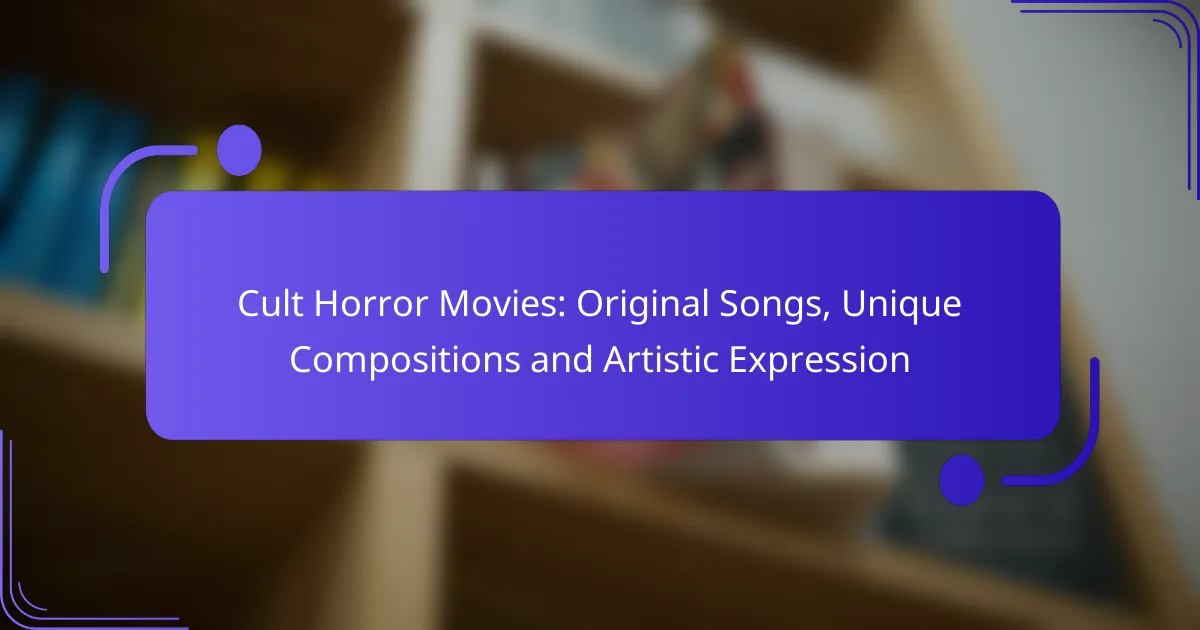Cult horror movies are renowned for their original songs and unique compositions that elevate the storytelling and atmosphere. These musical elements not only define the film’s identity but also forge lasting connections with audiences, enhancing the emotional depth and immersive experience. By employing innovative soundtracks and unconventional techniques, these films evoke a powerful sense of fear and tension, making them unforgettable cinematic experiences.
![]()
You can explore more about these themes on our homepage.
What Are the Most Iconic Cult Horror Movies with Original Songs?
Iconic cult horror movies often feature original songs that enhance their unique atmosphere and storytelling. These compositions not only contribute to the film’s identity but also resonate with audiences, creating memorable experiences that endure over time.
The Rocky Horror Picture Show
The Rocky Horror Picture Show is perhaps the most famous cult horror film featuring original songs. Released in 1975, its soundtrack includes catchy numbers like “Time Warp” and “Sweet Transvestite,” which have become cultural staples. The film’s interactive screenings encourage audience participation, further solidifying its status as a beloved classic.
Fans often dress up as characters and sing along, creating a communal experience that enhances the film’s allure. The music’s blend of rock, pop, and campy theatricality sets a tone that is both playful and provocative.
Suspiria (2018)
Suspiria (2018) stands out for its haunting score composed by Thom Yorke of Radiohead. The film’s music complements its unsettling visuals and themes of witchcraft and horror, creating an immersive atmosphere. The original songs, alongside instrumental pieces, evoke a sense of dread and beauty that aligns perfectly with the film’s narrative.
The combination of ethereal vocals and eerie soundscapes enhances the emotional depth of the story, making it a significant aspect of the viewing experience. The soundtrack has received acclaim for its artistic expression, contributing to the film’s cult status.
Donnie Darko
Donnie Darko features a distinctive soundtrack that includes original songs and carefully curated tracks from the 1980s. The film’s music plays a crucial role in establishing its surreal and psychological tone. Songs like “Mad World” by Gary Jules resonate deeply with the film’s themes of time travel and existential angst.
The eclectic mix of music not only enhances key scenes but also invites viewers to reflect on the narrative’s complexities. This soundtrack has become iconic in its own right, often associated with the film’s cult following.
Halloween III: Season of the Witch
Halloween III: Season of the Witch is unique within the Halloween franchise for its lack of Michael Myers and its focus on a different story. The film features an original score by John Carpenter, which is both eerie and memorable. The theme song, “Halloween III Theme,” captures the film’s unsettling atmosphere and has become a classic in horror music.
Despite mixed initial reception, the film has gained a cult following, partly due to its distinctive music that sets it apart from typical slasher films. The original compositions contribute to its eerie charm and have helped solidify its place in cult horror history.
Repo! The Genetic Opera
Repo! The Genetic Opera is a rock musical that combines horror and science fiction, featuring a completely original score. The film’s music, characterized by its gothic and operatic elements, drives the narrative and enhances its dark themes of genetic engineering and corporate greed. Songs like “Zydrate Anatomy” showcase the film’s unique style and storytelling approach.
This film has developed a passionate fanbase, with audiences often participating in sing-alongs during screenings. The original compositions are integral to the film’s identity, making it a standout in the realm of cult horror musicals.
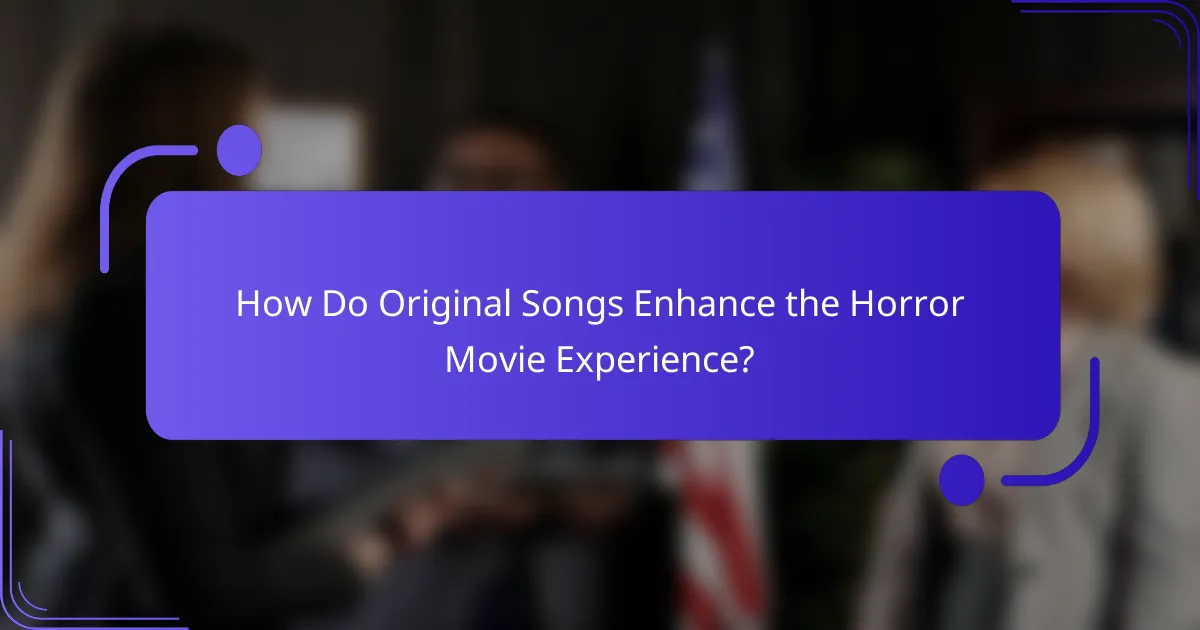
How Do Original Songs Enhance the Horror Movie Experience?
Original songs significantly enhance the horror movie experience by creating an immersive atmosphere, deepening emotional connections, and aiding character development. These unique compositions can evoke fear, tension, and suspense, making the viewing experience more impactful.
Creating Atmosphere
Original songs play a crucial role in establishing the atmosphere of a horror film. They can set the tone right from the opening credits, using dissonant chords or haunting melodies to instill a sense of dread. For example, a slow, eerie composition can enhance a suspenseful scene, drawing viewers into the unsettling world of the film.
Using soundscapes that incorporate natural sounds or unsettling rhythms can further amplify the horror elements. This combination of music and sound design creates a multi-layered auditory experience that keeps audiences on edge.
Emotional Engagement
Music in horror films is essential for emotional engagement, as it can evoke strong feelings of fear, anxiety, or empathy. A well-placed original song can resonate with viewers, making them feel the characters’ terror or despair more acutely. For instance, a poignant ballad during a tragic moment can heighten the emotional stakes, making the horror more relatable.
Moreover, the use of motifs or recurring themes can create a deeper connection with the audience, allowing them to anticipate events based on the music. This familiarity can intensify the emotional impact when a character faces danger.
Character Development
Original songs can also contribute to character development by reflecting their inner thoughts and struggles. A character’s theme can evolve throughout the film, mirroring their journey and emotional state. For example, a character’s transition from innocence to corruption might be represented by a shift in their musical theme from light and airy to dark and dissonant.
Additionally, songs can provide insight into a character’s motivations or backstory, enriching the narrative. By integrating music that aligns with a character’s arc, filmmakers can create a more profound understanding of their complexities, enhancing the overall storytelling experience.
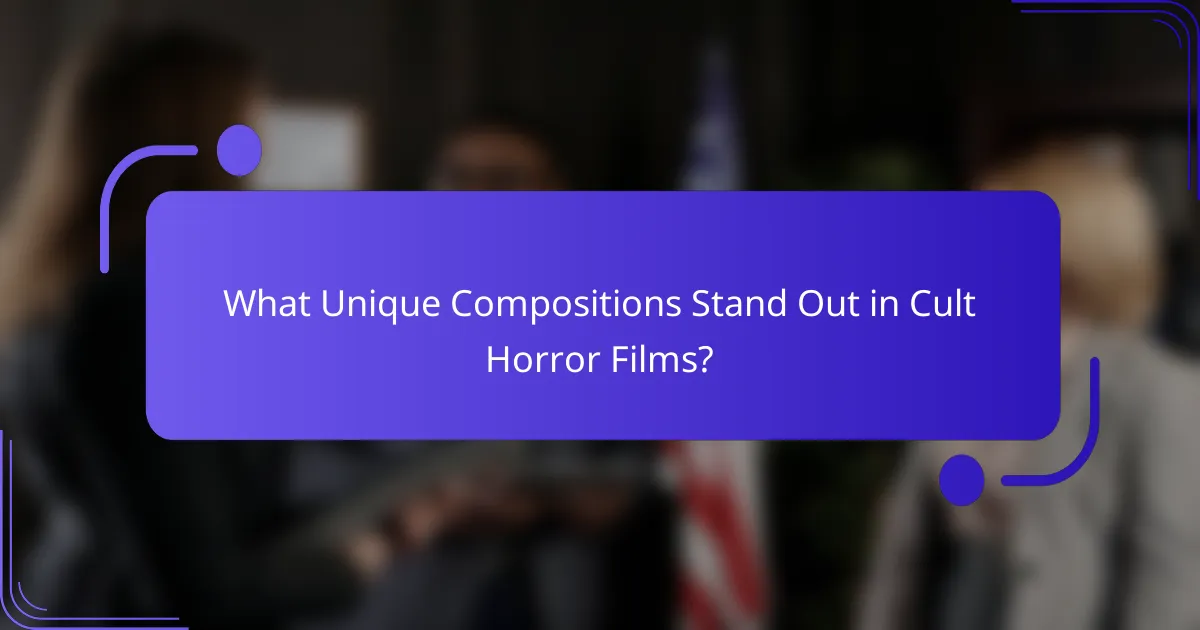
What Unique Compositions Stand Out in Cult Horror Films?
Unique compositions in cult horror films often feature innovative soundtracks that enhance the eerie atmosphere and emotional impact. These scores are characterized by their ability to evoke fear, tension, and unease, often using unconventional instruments and techniques.
John Carpenter’s Synth Scores
John Carpenter is renowned for his pioneering use of synthesizers in horror film scores, particularly in classics like “Halloween” and “The Thing.” His minimalist approach combines repetitive motifs with haunting melodies, creating a sense of dread that lingers throughout the film.
Carpenter’s scores often utilize simple, yet effective, synth lines that can be replicated with basic equipment. This accessibility has inspired many filmmakers and musicians to experiment with electronic music in their own horror projects.
Goblin’s Work in Italian Horror
The Italian progressive rock band Goblin is famous for their collaborations with director Dario Argento, particularly on films like “Suspiria” and “Profondo Rosso.” Their compositions blend rock elements with orchestral arrangements, producing a unique sound that heightens the visual horror.
Goblin’s music often features complex rhythms and unsettling harmonies, which contribute to the surreal and nightmarish quality of Argento’s films. Their innovative use of sound effects and vocalizations adds an additional layer of tension that is distinctive in the genre.
Trent Reznor’s Soundtracks
Trent Reznor, known for his work with Nine Inch Nails, has made significant contributions to horror soundtracks, particularly with films like “The Social Network” and “Gone Girl.” His scores often incorporate dark, ambient soundscapes that create an unsettling atmosphere, enhancing the psychological tension of the narratives.
Reznor’s ability to blend electronic music with traditional orchestration allows for a diverse range of emotional expression. His soundtracks often utilize dissonance and unexpected tonal shifts, making them memorable and impactful in the context of horror storytelling.
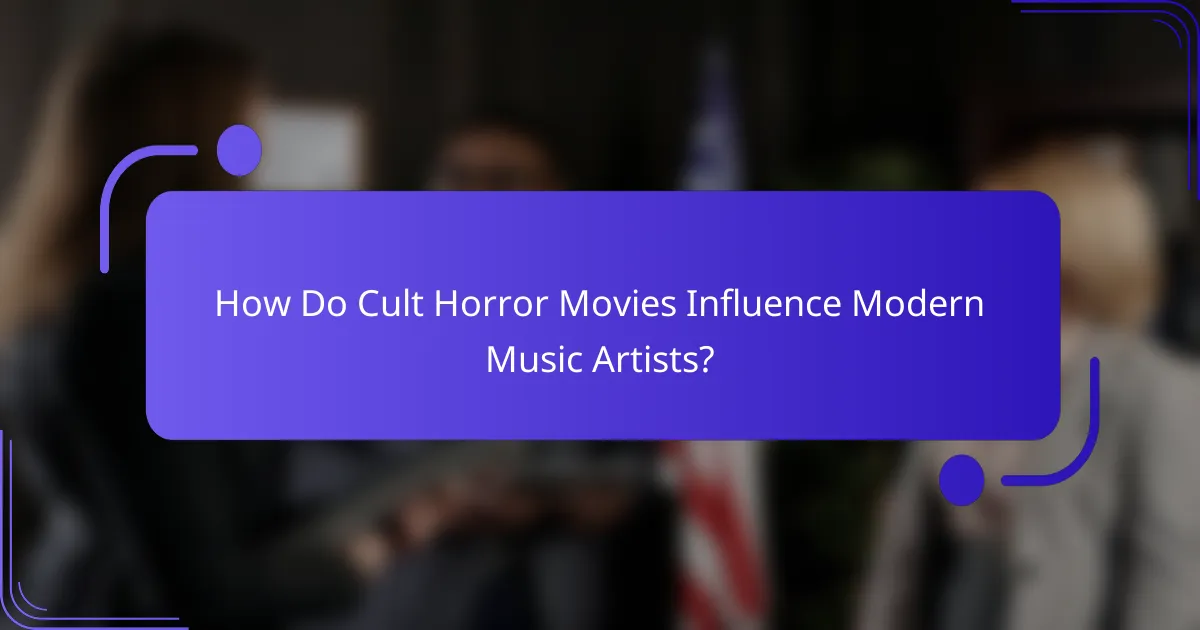
How Do Cult Horror Movies Influence Modern Music Artists?
Cult horror movies significantly shape modern music artists by inspiring unique sounds, themes, and visuals. These films often provide a rich source of material for musicians, leading to innovative compositions that reflect the eerie and unconventional aspects of horror storytelling.
Sampling in Contemporary Music
Sampling from cult horror movies is a popular technique among contemporary music artists, allowing them to incorporate iconic sound bites and atmospheric elements into their tracks. This practice not only pays homage to the films but also creates a distinct auditory experience that resonates with fans of both music and cinema.
For example, artists might use chilling dialogue or sound effects from classic horror films, blending them into genres like hip-hop or electronic music. This can enhance the emotional impact of a song, drawing listeners into a darker narrative.
Homages in Music Videos
Music videos often serve as a canvas for artists to pay tribute to cult horror films, using visual storytelling to evoke the same unsettling feelings. By incorporating stylistic elements, such as lighting, costume design, and thematic references, artists can create a compelling connection between their music and the horror genre.
For instance, a music video might feature scenes reminiscent of a famous horror film, complete with suspenseful pacing and eerie settings. This not only attracts fans of the genre but also enriches the artistic expression of the music itself.
Collaborations with Horror Filmmakers
Collaborations between musicians and horror filmmakers are becoming increasingly common, resulting in unique projects that blend sound and visual art. These partnerships can lead to original scores for films or music that captures the essence of a horror narrative.
Such collaborations often allow musicians to explore new creative avenues while filmmakers benefit from the fresh perspectives that artists bring. This synergy can elevate both the music and the film, creating a more immersive experience for audiences.
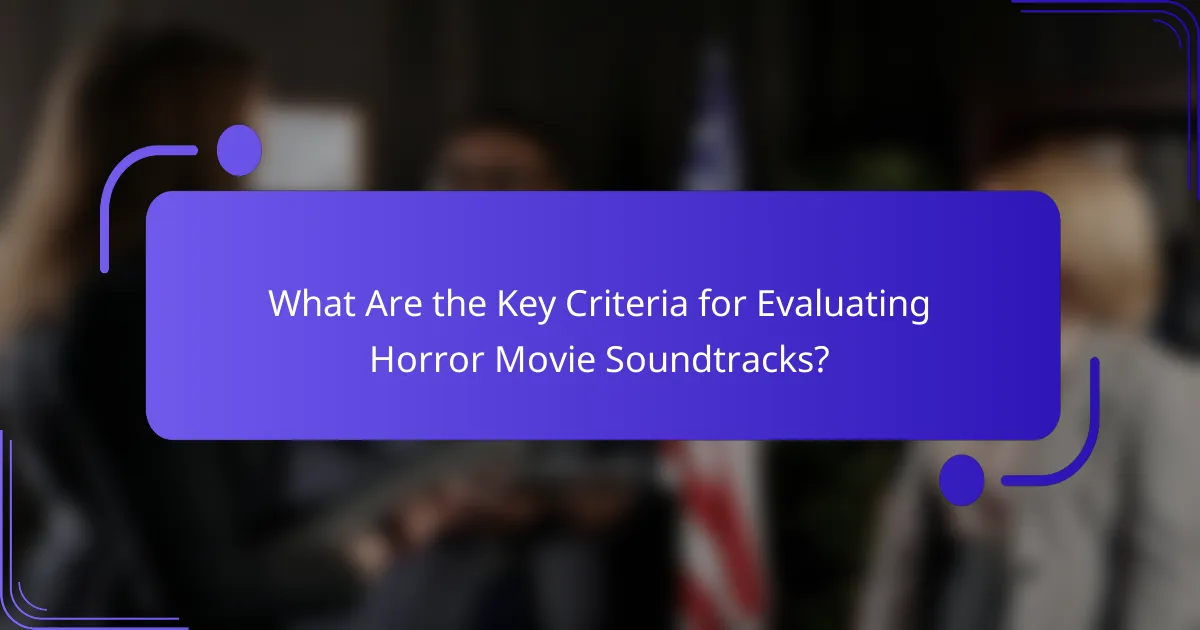
What Are the Key Criteria for Evaluating Horror Movie Soundtracks?
Evaluating horror movie soundtracks involves assessing several key criteria that contribute to the film’s overall atmosphere and emotional impact. Important factors include originality, thematic coherence, and the ability to enhance suspense and fear.
You can explore more about this in cult horror movie soundtracks.
Originality of Compositions
Originality in horror movie soundtracks is crucial for creating a unique auditory experience. Composers often experiment with unconventional instruments and sounds to evoke specific emotions. For instance, using dissonant chords or eerie soundscapes can effectively heighten tension and fear.
When evaluating originality, consider how well the soundtrack distinguishes itself from typical horror tropes. A memorable score often incorporates unexpected elements, such as blending classical music with modern electronic sounds, to create a fresh listening experience.
Thematic Coherence
Thematic coherence refers to how well the soundtrack aligns with the film’s narrative and emotional arcs. A strong horror score should reflect the film’s themes, whether it’s isolation, madness, or supernatural elements. For example, a soundtrack that uses haunting melodies can reinforce feelings of dread and suspense throughout the film.
To assess thematic coherence, listen for motifs that recur at key moments, enhancing the storytelling. Effective soundtracks often use variations of a central theme to mirror character development or plot twists, creating a deeper connection between the audience and the film.
Enhancement of Suspense and Fear
A successful horror movie soundtrack significantly enhances suspense and fear, keeping the audience on edge. This can be achieved through strategic use of silence, sudden crescendos, and unsettling sound effects. For example, a sudden drop in volume followed by a loud, jarring sound can create a shocking moment that amplifies fear.
When evaluating this criterion, consider how the soundtrack interacts with visual elements. A well-timed score can elevate a jump scare or a tense scene, making it more impactful. Look for soundtracks that effectively build tension over time, leading to climactic moments that leave a lasting impression.
